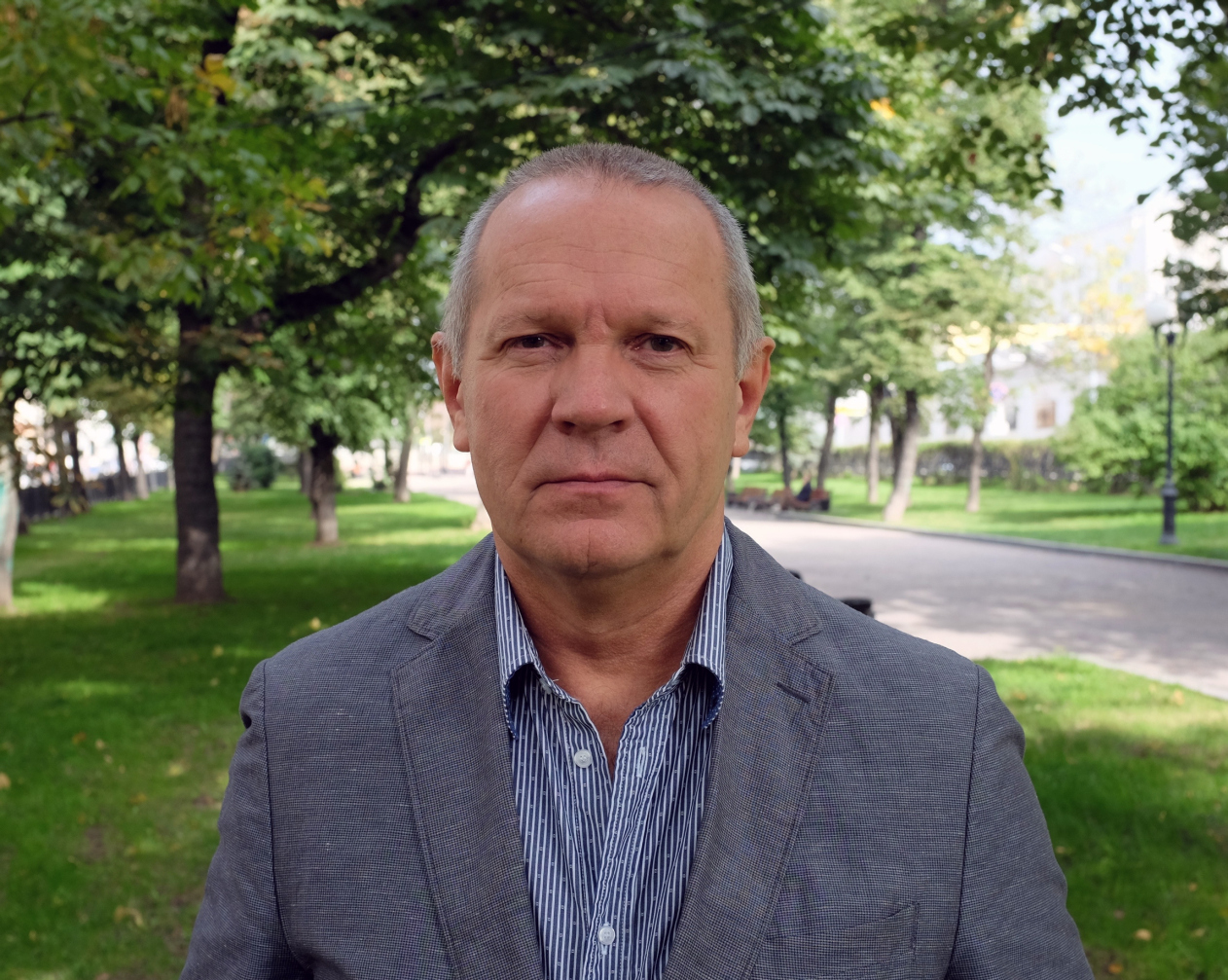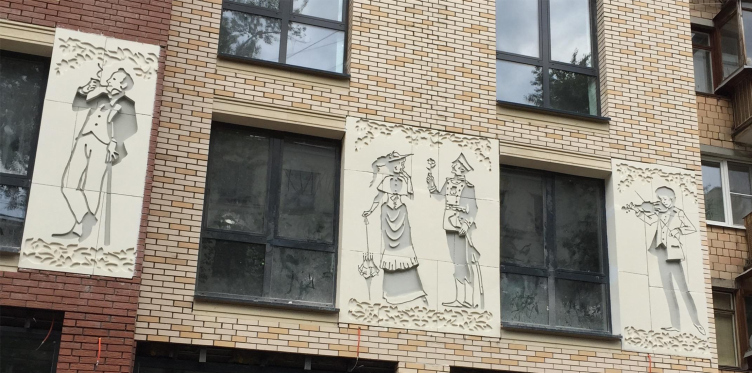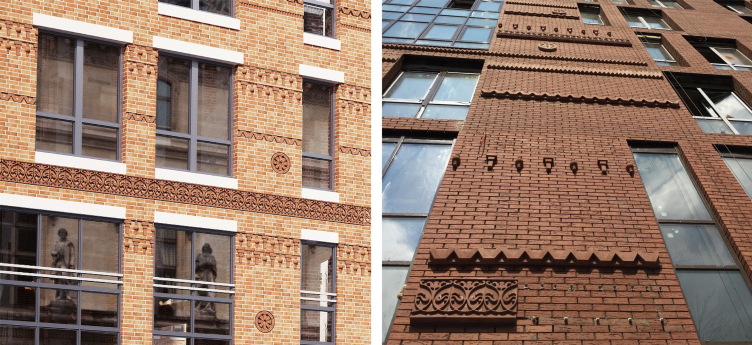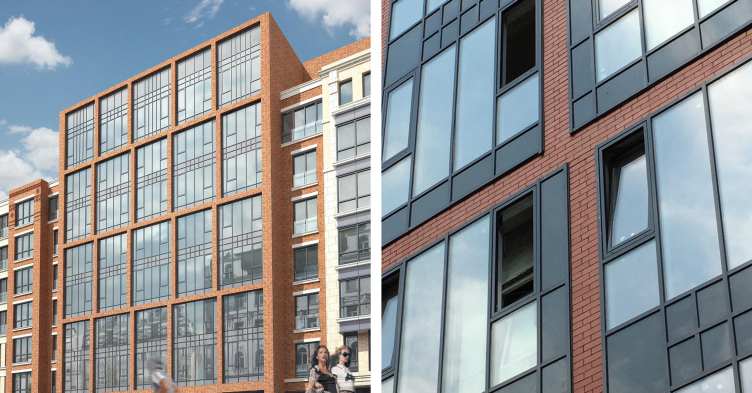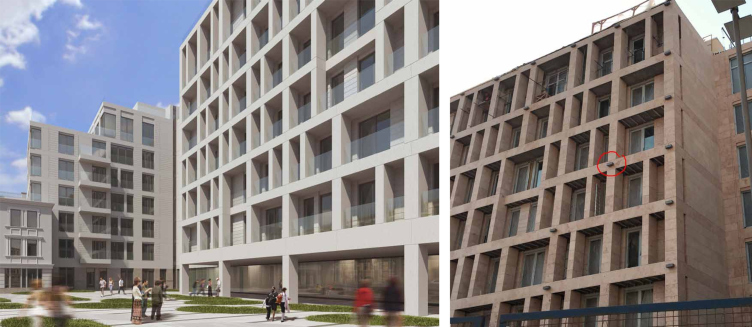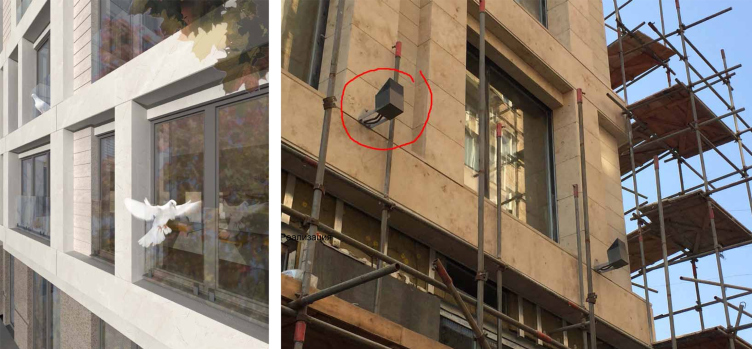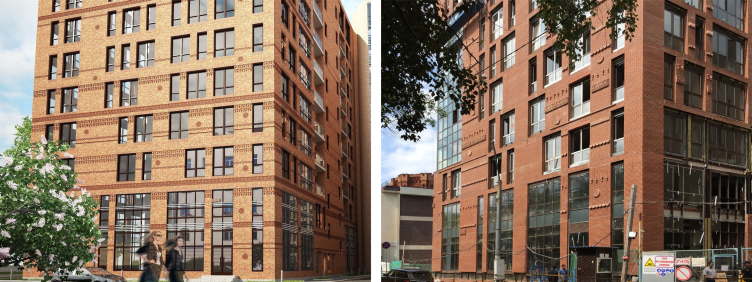It is about two projects whose construction is due to be completed this year - the residential and administrative center located at Moscow, Malaya Pirogovskaya, 8, Buildings 1, 2, and 3 (the developer being OAO "Moskovskaya Shelkokrurilnaya Fabrika Mosnitki"), as well as about a multifunctional complex located at Moscow, Smolensky Alley, 19-21 (the developer being ZAO "SK Donstroi"). The projects of both buildings were developed by OOO "Architectural studio Group ABV" whose leader is Nikita Biryukov.
Work on both projects began before the world economic crisis of 2008; right about that time the projects got all the necessary approvals of the "project" stage. After the two developer companies changed the project managers the newcomers asked for comparatively insignificant corrections to be made to the projects. However, when the construction work entered the stage of implementing the facades the developers stopped taking into consideration the architects' opinion altogether, making changes to the project on the fly and ignoring the comments and records in the author supervision journal.
In the case of the Malaya Pirogovskaya project (consists of four different parts) such intrusion resulted in the fact that one of the facades got unapproved by the architects giant concave reliefs showing images of Empire dames and cavaliers: what makes them different from the antique or Egyptian genre prototypes is the complete absence of any plasticity - the contours of the figures are roughly cut out in the concrete slabs. The same building on Malaya Pirogovskaya got a facade pasted onto the brickwork instead of the facade that was meant to be thrust into the brace of the brick structure, and also, instead of the brick ornaments of the facade brickwork, the customer simply glued on an enormous quantity of Styrofoam parts. During the period when the unsanctioned work was being done on the project, the developer's interests were represented by Alena Deryabina who acted on behalf of the developer on the basis of a proxy and, regretfully, would not listen to the architects' opinion on this matter.
Nikita Biryukov. Photo courtesy by "Group ABV"
Malaya Pirogovskaya, 8. The pannels unapproved by "Group ABV" and Moskomarkhitektura. Image courtesy by "Group ABV"
Malaya Pirogovskaya, 8. The pannels unapproved by "Group ABV" and Moskomarkhitektura. Image courtesy by "Group ABV"
Malaya Pirogovskaya, 8. On the left: facade upon the project by "Group ABV". On the right: the implemented facade with arbitrary substandard elements. Image courtesy by "Group ABV"
Malaya Pirogovskaya, 8. On the left: facade upon the project by "Group ABV". On the right: the implemented facade with arbitrary substandard elements. Image courtesy by "Group ABV"
The facades of the building in the Smolensky Alley, according to Nikita Biryukov, "suffered less but were still mangled". In this instance, "instead of white, almost crystal dolomite stone, the developer arbitrarily used rusty-yellow and beige-brown stone which made the facades look depressing" - claims the author. The picture was completed by large backlight posts made plainly visible: the backlighting project proposed by OOO "Architectural studio Group ABV" was ignored by the developers as well.
Smolensky Alley 19-21. On the left: facade upon the project by "Group ABV". On the right: the implemented facades with lements of arbitrarily chosen materials.Image courtesy by "Group ABV"
Smolensky Alley 19-21. On the left: fragment of the facade upon the project by "Group ABV".On the right: fragment of the facade with an arbitrarily installed spotlight unapproved by "Group ABV" and violating the aesthetics of the building.
Smolensky Alley 19-21. On the left: backlighting concept upon the project by "Group ABV".On the right: unapproved backighting concept. Image courtesy by "Group ABV"
Presently, OOO "Architectural studio Group ABV" has lodged a complaint with Moscow Federal Construction Supervision Board, as well as filed claims to the developer companies. Also, OOO "Architectural studio Group ABV" is prepared to seek damages for the copyright violation that will be forwarded to court upon the company getting the developer's official answer to the above-mentioned claims.
As of the moment of the publication of this article, we have not been able to get any comments from the representatives of "Donstroy".
We spoke to Nikita Biryukov about the details of this story.
Archi.ru:
- Russian architects are always complaining that this or that project of theirs was ruined at the implementation stage - but they never take this problem to court and they never stand for their rights. At least I cannot recall such a case - you are the first one on my personal record. What did it take to make such a decision?
Nikita Biryukov:
- In my case it was a lot more than just ruining the house, it's different. I really believe that these people crossed the line. I have never been in a situation where the architect's opinion would be so cynically and studiously ignored.
What they ultimately got at Malaya Pirogovskaya I cannot classify as anything but vulgarity. Everyone who knows us as architects is laughing when looking at that house and thinks that we completely lost our minds. I do not want to throw rocks at the author of the concave reliefs - but such three-meter panels with "magazine" graphics are something that just cannot be there at the facade.
- How did the idea of concave reliefs come about at all? Who was the prime mover?
- In one of our earlier versions of that project, there indeed was this concave relief idea; then we gave it up altogether and forgot about it. In our final version, we did bas-reliefs, professional and dramatic. There is a great number of examples of great architectural plastics, in Moscow alone you can take the Stalin architecture with lots of great sculptural elements - bas-reliefs and haut-reliefs.
We were categorically opposed to the idea of concave reliefs - as the authors we did not prescribe anything of the sort. We refused to participate in that but our opinion was completely ignored by the developers.
- What is your end game in court?
- First of all, we want the facades taken apart and then put together again in full accordance with our original project. We handed over to our customer all the working documents on the facades, and we have high-quality renders that we can put in court next to the photographs of the built houses. Everyone will be able to make a comparison and see just how different they are. Besides, we want to make a public statement, loud and clear: these are not our houses and this is not our architecture. We want to stand up for our rights; nobody in the architectural community does that, and I can't blame them - they are afraid of losing their job.
- Do you expect any pressure from the developers' side?
- Of course, they will try to pressure me, and for me this is not going to be a walkover. But the thing is that now they really feel that they can get away with it.
- Do you count on the support of the professional community? Did your colleagues support you? As far as I recall, this spring at "Arch Moscow" a lot was said about the architectural copyright...
- I tried to speak to my colleagues about that; many companies have similar problems with their developers but this never went anywhere beyond conversation. Strictly speaking, there's no community as such; a bunch personal interests is all there is. Because I am not what you would call a "refined" architect, but rather a fighter - and I've always been one - I do not really fit in with this architectural crowd; I meet few people and I live in a rather solitary way. I do not really care for what they call "public life". What I like about the Anglo-Saxon people is that they have unity - they line up in a boar's snout and go to fight for their rights. And as for the Russian architects, taken independently, they all are great people but there is no real architectural community in this country and I don't think there will be any time soon. This is why I stopped thinking about getting any kind of support and decided to take care of myself. My customer has overstepped the mark and I must react to it.
Malaya Pirogovskaya, 8. The pannels unapproved by "Group ABV" and Moskomarkhitektura. Image courtesy by "Group ABV"
The project implemented by "DONSTROY". Malaya Pirogovskaya, 8. On the left: facades upon the project by "Group ABV". On the right: facade with arbitrarily self-produced elements of substandard quality, unapproved by "Group ABV" and violating the aesthetic
The project implemented by "DONSTROY". Malaya Pirogovskaya, 8. On the left: facades upon the project by "Group ABV". On the right: facade with arbitrarily self-produced elements of substandard quality installed in the wrong way, unapproved by "Group ABV"
The project implemented by "DONSTROY". Malaya Pirogovskaya, 8. On the left: facades upon the project by "Group ABV". On the right: facade with arbitrarily self-produced elements of substandard quality installed in the wrong way, unapproved by "Group ABV"
The project implemented by "DONSTROY". Malaya Pirogovskaya, 8. On the left: facades upon the project by "Group ABV". On the right: facade with arbitrarily self-produced elements of substandard quality, unapproved by "Group ABV" and violating the aesthetic

